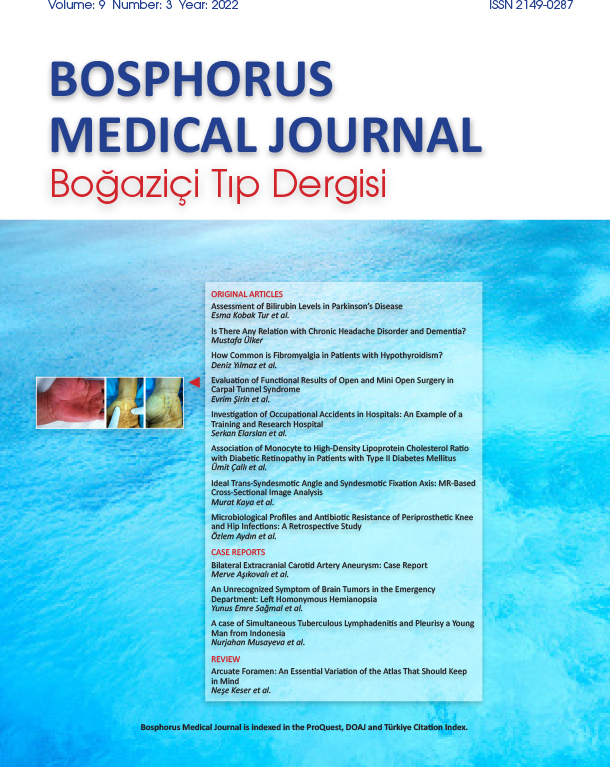Volume: 10 Issue: 2 - 2023
| FRONT MATTERS | |
| 1. | Frontmatters Pages I - VIII |
| ORIGINAL RESEARCH | |
| 2. | Depression and Sleep Quality in Restless Legs Syndrome/Willis-Ekbom Disease Ceyhun Sayman, Murat Fatih Pul, Buse Rahime Hasırcı Bayır doi: 10.14744/bmj.2022.04909 Pages 65 - 70 INTRODUCTION: Restless legs syndrome (RLS)/Willis-Ekbom disease (WED) is a well-known neurological sensory motor disorder. As a result of sleep fragmentation, quality of life has effected and incidence of anxiety and depression increase. Our aim with this study is to obtain the effects of RLS/WED on sleep quality and psychiatric well-being and their relationship with disease severity. METHODS: In total, 122 RLS/WED was diagnosed with RLS/WED according to the International RLS Study Group (IRLSSG) diagnostic criteria. All partipicantss sociodemographic data form, IRLSSG severity scale, Pittsburgh Sleep Quality Index (PSQI), Epworth Sleepiness Scale (EUI), and Beck Depression Inventory (BDI) were filled up by senior neurologists. Frequency of depressive symptoms, excessive daytime sleepiness, and poor sleep quality were examined. RESULTS: 122 patients (94 [77%] female and 28 [23%] male) diagnosed with primary RLS/WED according to IRLSSG criteria were included into the study. The severity level of RLS/WED in 19 (15.5%) of the patients was mild-moderate, 65 (53,2%) were severe, and 38 patients (31,2%) were very serious. BDI mean score of RLS/WED patients is 15.2±9 and EUI mean score of RLS/WED patients is 5±3.7. There was no statistically significant difference between the groups determined according to the severity of the disease. PSQI mean score of RLS/WED patients is 9.5±3.8. There was statistically significant difference between the groups determined according to the severity of the dis-ease. Significant differences between the groups of RLS/WED patients were found on PSQI, especially in sleep duration, efficiency, and daytime sleep dysfunction. DISCUSSION AND CONCLUSION: Many diseases such as depression accompany with RLS/WED. Early recognition and treatment of these comorbid conditions is very important for the clinical progression of the disease. |
| 3. | Magnetic Resonance Imaging/Ultrasound Fusion-Guided Corticosteroid Injection to Synovial and Ligamentous Portion of Sacroiliac Joint in Patients with Axial Spondyloarthritis Kemal Sarı, Ilknur Aktaş, Feyza Ünlü Özkan, Ahmet Nedim Kahraman, Ahmet Vural, Kenan Akgün doi: 10.14744/bmj.2022.65882 Pages 71 - 77 INTRODUCTION: The objective of the study was to retrospectively evaluate the feasibility of the magnetic resonance imaging (MRI)-ultrasonography (US) fusion system for the guidance of sacroiliac joint (SIJ) injections and the clinical results of patients who underwent intra-articular and peri-articular injections. METHODS: In this study, MRI-US fusion-guided SIJ injections in 10 patients with active sacroiliitis were evaluated retrospectively. Injections were made in the synovial part of the SIJ in 5 patients and in the ligamentous part in 5 patients. RESULTS: Injections were successful in treating pain in all patients. There was no significant difference in clinical responses (post-injection 2nd week and 3rd month) between synovial or ligamentous injection groups. DISCUSSION AND CONCLUSION: The MRI-US fusion method is an effective and reliable option for SIJ injection guidance. There is no difference in the effectiveness of corticosteroid injections into the synovial or ligamentous compartment in the management of sacroiliitis in spondyloarthritis patients. |
| 4. | Increased Seizure Risk Among the Patients During the COVID-19 Pandemic: Is a Single-Drug Regime Better? Ümmü Serpil Sarı, Figen Tokuçoğlu doi: 10.14744/bmj.2022.99815 Pages 78 - 82 INTRODUCTION: Increased stress, anxiety, depression, multi-anti-epileptic drug usage, and COVID-19 infection were all being related with an increased rate of seizures among subjects with epilepsy. Thus, in this study, we aimed to investigate whether social isolation increased the frequency of seizures among the cases with epilepsy during the COVID-19 pandemic and to define the possible underlying cause of it. METHODS: In this retrospective, cross-sectional study, 103 subjects with a diagnosis of epilepsy were included in the study. Hospital anxiety and depression scales were used to determine the underlying anxiety and depression. RESULTS: In this study, 58 out of 103 subjects were female and 51.4% of them had focal epilepsy. Subjects in focal and generalized epilepsy groups were similar based on age, gender, the presence of comorbid diseases, and anxiety and depression scores. However, the subjects presenting with increased rates of seizure had higher anxiety scores and more comorbid diseases, and in addition, the majority of them were on multi-anti-epileptic medications. DISCUSSION AND CONCLUSION: The risk of having an increased seizure rate was greater among the subjects with epilepsy who were on multi-anti-epileptic drugs and who had comorbid diseases and increased anxiety scores. |
| 5. | Evaluation of Anterior Chamber Parameters in Keratoconus Patients with Post-Deep Anterior Lamellar Keratoplasty Glaucoma Ümit Çallı, Baran Kandemir doi: 10.14744/bmj.2022.97659 Pages 83 - 87 INTRODUCTION: The purpose of this study was to evaluate iridocorneal angle (ICA) and anterior chamber depth (ACD) that would be associated related to trabecular alteration as a cause of glaucoma following deep anterior lamellar keratoplasty (DALK). METHODS: Ninety-eight eyes of 98 keratoconus (KC) patients were included in this study. We compared pre-operative and post-operative 1st-year values of the ACD and ICA of patients with and without glaucoma following DALK. RESULTS: Four patients (4.1%) had glaucoma following DALK. Pre-operative ACD was 4.24±0.64 mm and it reduced to 3.41±0.44 mm post-operatively in glaucoma patients following DALK and; 4.12±0.56 mm and it reduced to 3.35±0.53 mm postoperatively in patients without glaucoma following DALK. Pre-operative ICA was 48.65±7.08 and it reduced to 48.05±13.14 post-operatively in glaucoma patients following DALK and; 49.48±7.62 and it reduced to 47.96±10.32 post-operatively in patients without glaucoma following DALK. DISCUSSION AND CONCLUSION: Our results demonstrate that ACD and ICA values are not significantly different between both groups with or without post-DALK glaucoma in KC patients. |
| 6. | The Differences Between the Frequency of Getting Sick of Health Personnel of Samsun Education and Research Hospital During the Second and Third Wave Period of COVID-19: A Cross-Sectional Study Derya Kılıç Köksal, Vaner Koksal, Göknur Yapar Toros, Yelda Ersözlü Bakırtaş, Ebru Ulaş, Turgay Bozkurt, Şule Özdemir doi: 10.14744/bmj.2022.69672 Pages 88 - 94 INTRODUCTION: The COVID-19 pandemic has attracted all the attention due to the loss of workforce and deaths that it has caused in the world and in our country. Vaccine and drug studies are still going on to control the virus. The effectiveness of the vaccines is very important to apply in to conclude the pandemic. For this reason, we investigated the incidence of COVID-19 disease in the seasonal waves of autumn and spring in health personnel of Samsun Education and Research Hospital (SERH). METHODS: Health personnel diagnosed with PCR+, COVID-19 who applied to SERH occupational medicine unit between September 2020 and June 2021 were retrospectively scanned. Age, gender, occupational groups, working units, and vaccination status were examined. RESULTS: With the start of vaccination of risky groups in Türkiye, the first dose of COVID-19 vaccine was administered to health personnel in February 2021. A total of 854 health personnel were infected with COVID-19 in the date range were determined. Between September 1, 2020, and January 30, 2021, 659 (77.2%) patients were identified, who have not been vaccinated for COVID-19. After January 30, 2021, until June 31, 2021, 195 (22.8%). It was determined that the hospital staff caught COVID-19. DISCUSSION AND CONCLUSION: It was observed that the spring season of 2021 peak in Türkiye and Samsun province showed a more aggressive course than 2020 autumn season peak. It was determined that fewer health personnel were caught COVID-19 during the 3rd wave compared to the 2nd wave in the health personnel of SERH and vaccination has been shown to reduce the prevalence of COVID-19 infection. It has also been shown that the prevalence of contracting COVID-19 infection is the highest in the emergency room. |
| 7. | Determination of the Diet Quality and Emotional Appetite of Overweight and Obese Individuals Who Consult to the Nutrition and Diet Clinic During the Pandemic Period Deran Dalbudak Sansar, Erkan Deniz Dinçer doi: 10.14744/bmj.2023.92005 Pages 95 - 104 INTRODUCTION: This study was conducted to determine the diet quality and emotional appetite of overweight and obese adults aged 1865 years. METHODS: A total of 80 overweight and obese adults who applied to a state hospital diet outpatient clinic during the pandemic period of May 2021 participated in this descriptive cross-sectional study. In the study, a questionnaire consisting of demographic information, nutritional habits, and 24-h food consumption record and emotional appetite questionnaire prepared by the researchers were used as data collection tools. Weight and height measurements were taken of the participants, whose mean age was 45.85±13.59 years, and body mass index (BMI) was calculated. RESULTS: Of the 80 people who participated in the study, 63.7% were women and 36.3% were men. About 43.7% of the individuals were at primary school or below education level. In both groups, daily dietary intake of energy, protein, fat, carbohydrate, vitamin A, vitamin C, riboflavin, sodium, and phosphorus were higher than recommended amounts in TUBER, while potassium intake was low. There was no difference between the men and women participating in the study and in the positive or negative appetite scores of the demographic characteristics of the people. While there was no difference in positive emotions in the case of appetite during the pandemic period, a difference was observed in those whose appetite decreased in negative moods. DISCUSSION AND CONCLUSION: As a result, it was observed that the energy, carbohydrate, fat, and protein consumption of overweight and obese individuals participating in the study were higher than recommended. This result is normal since the individuals included in the study were selected from individuals with BMI values higher than 24.9 kg/m². There was no significant difference between demographic characteristics and emotional appetites of individuals. While there was no change in positive emotions or appetite, it was observed that negative emotions affected appetite. |
| 8. | Patent Foramen Ovale Management in Cryptogenic Stroke Patients: Real-Life Data Collection Kadriye Güleda Keskin, Işıl Kalyoncu Aslan, Leyla Ramazanoğlu, Ceren Erkalaycı doi: 10.14744/bmj.2023.37232 Pages 105 - 110 INTRODUCTION: Ischemic stroke is still an important cause of morbidity and mortality in our country and in the world despite the developments in its treatment in recent years. Stroke recurrence can be avoided by determining the cause of the stroke and planning an effective treatment. To underline the Trial of ORG 10172 in Acute Stroke Treatment (TOAST) classification, it is important to define and follow undetected (cryptogenic) strokes. Patent foramen ovale (PFO) plays a role in 4050% of the etiology of cryptogenic strokes. PASCAL study has been published on the course of action if PFO is detected. In this way, the anatomical features of the PFO as well as the clinical features of the patient are evaluated in terms of which treatment to be decided in the patients. METHODS: For this purpose, a retrospective evaluation of 42 patients who presented to our clinic with ischemic stroke/TIA and were later discovered to have PFO was assessed. The risk of paradoxical embolism score was determined by asking the patients about their age, smoking status, HT, DM, history of TIA /ischemic stroke, and cortical infarction. RESULTS: In 18 of the patients, it was observed that the decision to close the PFO had been made. These patients were in the possible or prob-able group in the PASCAL classification. Nine of our 11 patients who did not have PFO closure had medical follow-up with antiaggregant therapy and two of them had started oral anticoagulant therapy. The patients who started taking anticoagulants AF found on the rhythm holter assessment. In the short-term follow-up (36 months) of our patients, no new attack was observed in either treatment group. DISCUSSION AND CONCLUSION: When PFO is detected in patients presenting with ischemic stroke, long-term results are needed with close follow-up and a coordinated study with cardiology. |
| 9. | Effects of Early Period Physical Therapy and Ergotherapy Applications on Daily Activity Levels After Open Reduction and Internal Fixation in Metacarpal Fractures Celaleddin Bildik, Barış Yılmaz doi: 10.14744/bmj.2023.05658 Pages 111 - 116 INTRODUCTION: Metacarpal fractures are one of the most common fractures. The primary goal in the post-operative rehabilitation of surgically treated metacarpal fractures is to bring the locomotor function of the relevant region closer to its pre-injury function. The aim of our study was to examine the effects of physical therapy and ergotherapy applications, which are initiated after the early period of plate osteosynthesis in metacarpal fractures, on the activity levels of daily life. METHODS: A post-operative rehabilitation program was started with 20 volunteers who had undergone an operation due to a metacarpal fracture. In the first stage, after pain control was achieved on the same post-operative day, patients were started with finger and wrist range of motion exercises. In the second stage, physical therapy exercises were given. In the third stage, the ergotherapy program was implemented. The Disabilities of the Arm, Shoulder, and Hand (DASH) questionnaire, Milliken Daily Living Activity, Assessment, and Hand Grip Strength Measurement Test were performed 3 times for each patient in the early post-operative period, after physical therapy, and after ergotherapy. RESULTS: In the evaluation of the DASH scores which were performed after the operation, after physical therapy, and after ergotherapy, the scores after ergotherapy were found to be statistically significant (p<0.001). In addition, when comparing the results of Milliken scoring and Hand Grip Strength Measurement Tests, the scores after ergotherapy were found to be statistically significant (p<0.001). DISCUSSION AND CONCLUSION: Three weeks of combined physical therapy and ergotherapy for surgically treated metacarpal fractures within 816 weeks post-operatively have been shown to have better functional outcomes, better grip strength, and higher efficacy compared to physiotherapy alone. |
| CASE REPORT | |
| 10. | Marchiafava-Bignami Disease with Cortical Involvement: A Case Report Buse Gül Belen, Ceyda Doğan, Mehmet Güney Şenol, Mehmet Fatih Özdağ doi: 10.14744/bmj.2023.60251 Pages 117 - 120 Marchiafava-Bignami disease is a rare, chronic alcoholism related disease which characterized with corpus callosum demyelination and necrosis. Marchiafava-Bignami disease typically begins in the body of the corpus callosum and later involves the genu and then splenium. Cortical lesions are rare, and they are known to have a poor prognosis. In our case, we will describe a 46-year-old chronic alcoholic male patient who uses alcohol for 30 years, with unusual cranial MRI findings like cortical involvement and a good prognosis. |




















